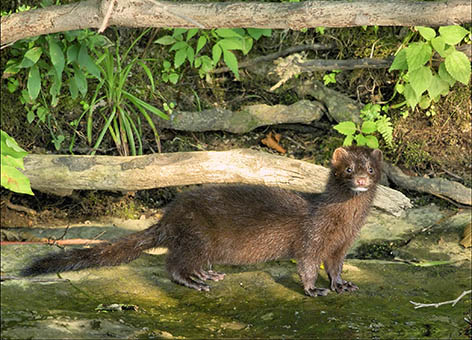Baby Mink Jeopardized by Toxic Chemicals in New York's Hudson River

APRIL 15, 2013 — This is a guest post by U.S. Fish and Wildlife Service biologist Kathryn Jahn, case manager for the Hudson River Natural Resource Damage Assessment. This story originally appeared in full on the U.S. Fish and Wildlife Service Northeast Region blog.
In the early 1970s, toxic compounds known as polychlorinated biphenyls, or PCBs, were discovered in the water, fish, and sediment of the Hudson River below General Electric Company's plants at Hudson Falls and Fort Edward in New York. Those PCBs have contaminated the surface water, groundwater, sediments, and floodplains of the Hudson River. We find that living resources at every level of the Hudson River's food chains are contaminated with PCBs. We believe that serious adverse effects are likely to be occurring to wildlife exposed to this PCB contamination in the Hudson River. A whole team of people are using their individual and collective expertise to address the problem of PCB contamination in the Hudson River and its effect on wildlife.
My favorite part of this job is the teamwork among all the people working on this issue, and the interactions with our experts and the public. We know that PCBs can cause serious harm to wildlife and other natural resources. Although a cleanup funded by GE is underway for certain sections of the Hudson River, the dredging GE is doing will leave some areas still contaminated with PCBs. The dredging also cannot compensate for past effects of this PCB contamination on the Hudson River's natural resources. For example, dredging will not make up for all the years that public use of the Hudson River fishery has been impaired by fish consumption advisories. Dredging will not return that lost use to the public. In our planning to determine the effects of PCBs on wildlife, we identified mink health as one area to investigate.
Mink are vulnerable to the effects of PCBs. Hudson River mink eat PCB-contaminated fish and other small creatures, and they ingest contaminated water, soil, and sediments as they look for food and build their dens. This led us to suspect that Hudson River mink might be harmed by PCBs in their environment. Read more to find out how PCB contamination might be affecting mink offspring. [Editor's note: And learn about a past report from the Hudson River Natural Resource Trustees, including NOAA, which found that PCBs permeate nearly every part of the Hudson River.]
